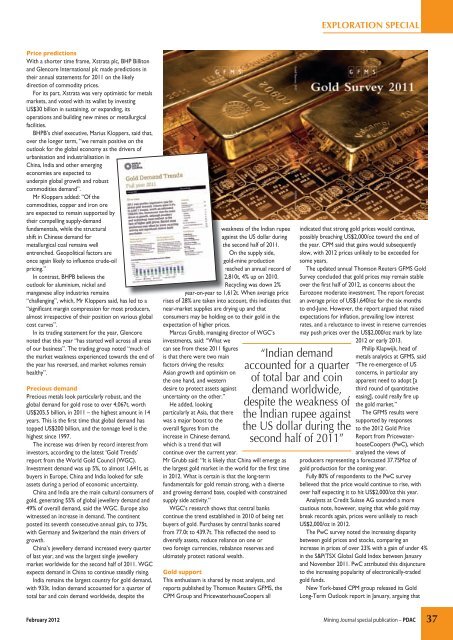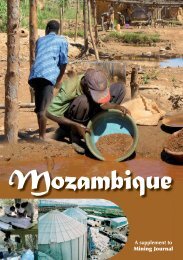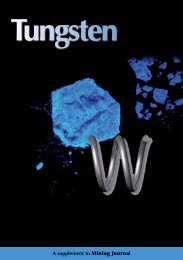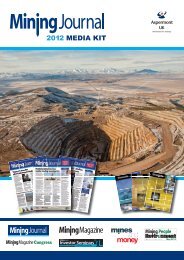Download Supplement PDF - Mining Journal
Download Supplement PDF - Mining Journal
Download Supplement PDF - Mining Journal
Create successful ePaper yourself
Turn your PDF publications into a flip-book with our unique Google optimized e-Paper software.
Price predictions<br />
With a shorter time frame, Xstrata plc, BHP Billiton<br />
and Glencore International plc made predictions in<br />
their annual statements for 2011 on the likely<br />
direction of commodity prices.<br />
For its part, Xstrata was very optimistic for metals<br />
markets, and voted with its wallet by investing<br />
US$30 billion in sustaining, or expanding, its<br />
operations and building new mines or metallurgical<br />
facilities.<br />
BHPB’s chief executive, Marius Kloppers, said that,<br />
over the longer term, “we remain positive on the<br />
outlook for the global economy as the drivers of<br />
urbanisation and industrialisation in<br />
China, India and other emerging<br />
economies are expected to<br />
underpin global growth and robust<br />
commodities demand”.<br />
Mr Kloppers added: “Of the<br />
commodities, copper and iron ore<br />
are expected to remain supported by<br />
their compelling supply-demand<br />
fundamentals, while the structural<br />
shift in Chinese demand for<br />
metallurgical coal remains well<br />
entrenched. Geopolitical factors are<br />
once again likely to influence crude-oil<br />
pricing.”<br />
In contrast, BHPB believes the<br />
outlook for aluminium, nickel and<br />
manganese alloy industries remains<br />
“challenging”, which, Mr Kloppers said, has led to a<br />
“significant margin compression for most producers,<br />
almost irrespective of their position on various global<br />
cost curves”.<br />
In its trading statement for the year, Glencore<br />
noted that this year “has started well across all areas<br />
of our business”. The trading group noted “much of<br />
the market weakness experienced towards the end of<br />
the year has reversed, and market volumes remain<br />
healthy”.<br />
Precious demand<br />
Precious metals look particularly robust, and the<br />
global demand for gold rose to over 4,067t, worth<br />
US$205.5 billion, in 2011 – the highest amount in 14<br />
years. This is the first time that global demand has<br />
topped US$200 billion, and the tonnage level is the<br />
highest since 1997.<br />
The increase was driven by record interest from<br />
investors, according to the latest ‘Gold Trends’<br />
report from the World Gold Council (WGC).<br />
Investment demand was up 5%, to almost 1,641t, as<br />
buyers in Europe, China and India looked for safe<br />
assets during a period of economic uncertainty.<br />
China and India are the main cultural consumers of<br />
gold, generating 55% of global jewellery demand and<br />
49% of overall demand, said the WGC. Europe also<br />
witnessed an increase in demand. The continent<br />
posted its seventh consecutive annual gain, to 375t,<br />
with Germany and Switzerland the main drivers of<br />
growth.<br />
China’s jewellery demand increased every quarter<br />
of last year, and was the largest single jewellery<br />
market worldwide for the second half of 2011. WGC<br />
expects demand in China to continue steadily rising.<br />
India remains the largest country for gold demand,<br />
with 933t. Indian demand accounted for a quarter of<br />
total bar and coin demand worldwide, despite the<br />
February 2012<br />
weakness of the Indian rupee<br />
against the US dollar during<br />
the second half of 2011.<br />
On the supply side,<br />
gold-mine production<br />
reached an annual record of<br />
2,810t, 4% up on 2010.<br />
Recycling was down 2%<br />
year-on-year to 1,612t. When average price<br />
rises of 28% are taken into account, this indicates that<br />
near-market supplies are drying up and that<br />
consumers may be holding on to their gold in the<br />
expectation of higher prices.<br />
Marcus Grubb, managing director of WGC’s<br />
investments, said: “What we<br />
can see from these 2011 figures<br />
is that there were two main<br />
factors driving the results:<br />
Asian growth and optimism on<br />
the one hand, and western<br />
desire to protect assets against<br />
uncertainty on the other.”<br />
He added, looking<br />
particularly at Asia, that there<br />
was a major boost to the<br />
overall figures from the<br />
increase in Chinese demand,<br />
which is a trend that will<br />
continue over the current year.<br />
Mr Grubb said: “It is likely that China will emerge as<br />
the largest gold market in the world for the first time<br />
in 2012. What is certain is that the long-term<br />
fundamentals for gold remain strong, with a diverse<br />
and growing demand base, coupled with constrained<br />
supply side activity.”<br />
WGC’s research shows that central banks<br />
continue the trend established in 2010 of being net<br />
buyers of gold. Purchases by central banks soared<br />
from 77.0t to 439.7t. This reflected the need to<br />
diversify assets, reduce reliance on one or<br />
two foreign currencies, rebalance reserves and<br />
ultimately protect national wealth.<br />
Gold support<br />
This enthusiasm is shared by most analysts, and<br />
reports published by Thomson Reuters GFMS, the<br />
CPM Group and PricewaterhouseCoopers all<br />
“Indian demand<br />
accounted for a quarter<br />
of total bar and coin<br />
demand worldwide,<br />
despite the weakness of<br />
the Indian rupee against<br />
the US dollar during the<br />
second half of 2011”<br />
EXPLORATION SPECIAL<br />
indicated that strong gold prices would continue,<br />
possibly breaching US$2,000/oz toward the end of<br />
the year. CPM said that gains would subsequently<br />
slow, with 2012 prices unlikely to be exceeded for<br />
some years.<br />
The updated annual Thomson Reuters GFMS Gold<br />
Survey concluded that gold prices may remain stable<br />
over the first half of 2012, as concerns about the<br />
Eurozone moderate investment. The report forecast<br />
an average price of US$1,640/oz for the six months<br />
to end-June. However, the report argued that raised<br />
expectations for inflation, prevailing low interest<br />
rates, and a reluctance to invest in reserve currencies<br />
may push prices over the US$2,000/oz mark by late<br />
2012 or early 2013.<br />
Philip Klapwijk, head of<br />
metals analytics at GFMS, said<br />
“The re-emergence of US<br />
concerns, in particular any<br />
apparent need to adopt [a<br />
third round of quantitative<br />
easing], could really fire up<br />
the gold market.”<br />
The GFMS results were<br />
supported by responses<br />
to the 2012 Gold Price<br />
Report from PricewaterhouseCoopers<br />
(PwC), which<br />
analysed the views of<br />
producers representing a forecasted 37.75Moz of<br />
gold production for the coming year.<br />
Fully 80% of respondents to the PwC survey<br />
believed that the price would continue to rise, with<br />
over half expecting it to hit US$2,000/oz this year.<br />
Analysts at Credit Suisse AG sounded a more<br />
cautious note, however, saying that while gold may<br />
break records again, prices were unlikely to reach<br />
US$2,000/oz in 2012.<br />
The PwC survey noted the increasing disparity<br />
between gold prices and stocks, comparing an<br />
increase in prices of over 23% with a gain of under 4%<br />
in the S&P/TSX Global Gold Index between January<br />
and November 2011. PwC attributed this disjuncture<br />
to the increasing popularity of electronically-traded<br />
gold funds.<br />
New York-based CPM group released its Gold<br />
Long-Term Outlook report in January, arguing that<br />
<strong>Mining</strong> <strong>Journal</strong> special publication – PDAC<br />
37









